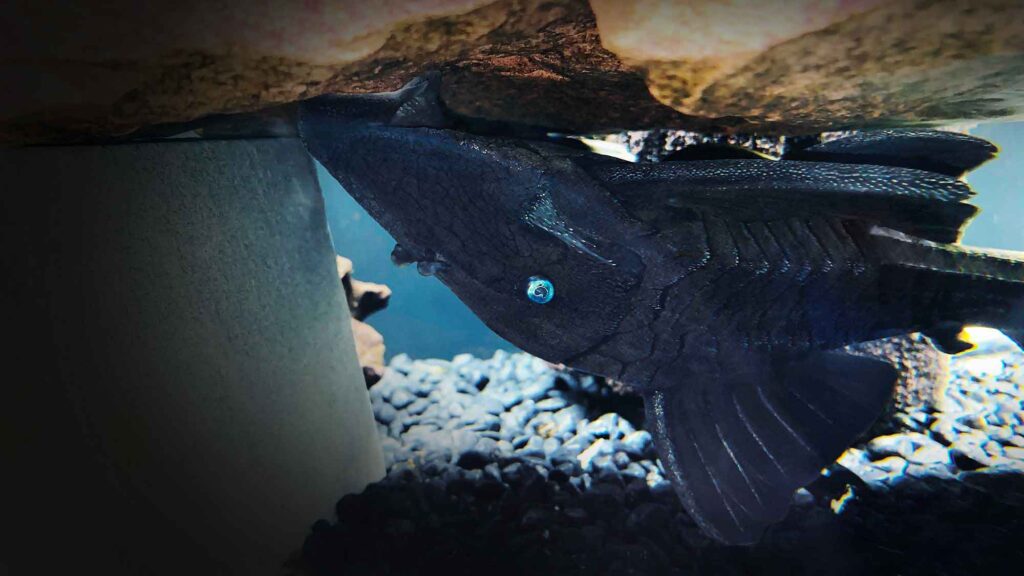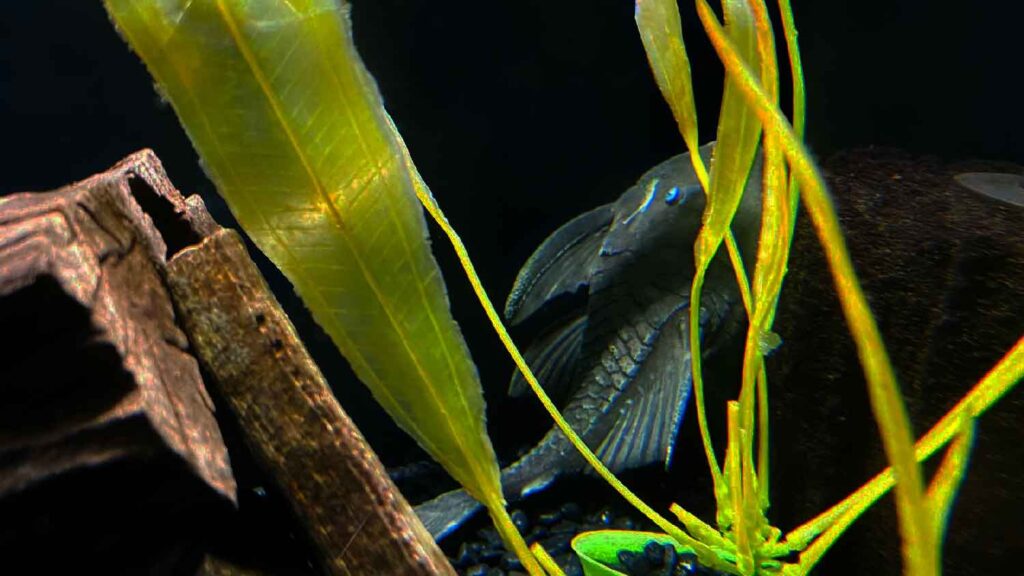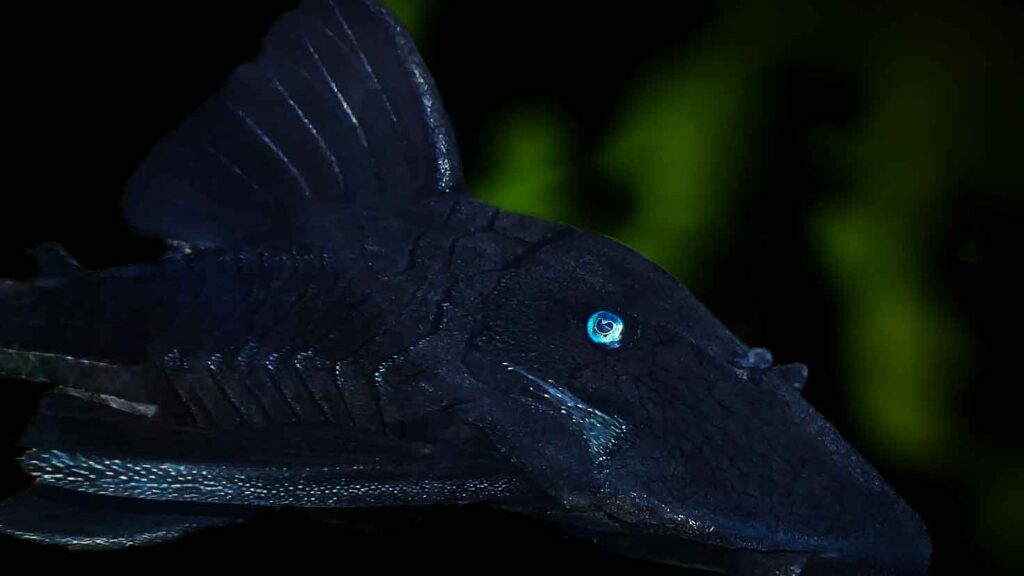The Blue Eyed Pleco (Panaque cochliodon) is by far one of the most beautiful fish in the Loricariidae family. This pleco adds beauty and a diverse look to any aquarium and will grasp anyone’s attention to themselves. This large pleco won’t cause any problem or disruption in the tank and is very easy to care for. Despite this, if you want your Blue Eyed Pleco to thrive, you might need to make a few adjustments to your fish tank setup.
This article will guide you through everything you need to know about the Blue Eyed Pleco. We cover care, growth rate, lifespan, breeding, size, diet, and more!
Species Profile & Overview
Blue Eyed Plecos are naturally found in different parts of Río Magdalena, Colombia. They are one of the oldest plecos kept in the aquarium hobby and are famous for their black body and beautiful blue eyes.
Their boney back and dark black color are specially adapted to the region they live in which helps them to protect themselves from other fish. They are fully black in color and have a bold cylinder-shaped body.
Almost all the Blue Eyed Pleco sold are coming from the wild. This is because these fish do not breed in captivity. Many home-based breeders have tried to breed this fish but no positive result has yet been reported.
That being said, these popular plecos are very rare and are rarely available in pet stores. If you manage to see one available you will probably see a very high price tag which is why not many stores offer them.
Despite their size, they are very shy and mostly active during the night time when they feel the safest. It is highly recommended to add a lot of caves and hiding spots so they can stay stress-free during the day.
Appearance:

Blue Eyed Pleco are very unique pleco both in terms of color and body shape. They have a dark black body with 2 small blue eyes. Their body color helps them swim around at nights without being seen by predatory fish. In an aquarium environment, these fish are a true attention grabber. No matter what type of fish they share a tank with, they will always grab viewers attention.
Blue Eyed Pleco shares the same external anatomy as other plecos, just with slight differences in mass and size. They have a bony back with their mouth underturned towards the belly. Their flat and soft belly is one of their vulnerable body parts.

Same as all Loricariidae family members, Blue Eyed Pleco fins are bold and threaded but are fully black. They have 8 fins across the body where dorsal and tail fins being the largest.
Despite being all black, Blue Eyed Pleco back plates overlap on each other and create a beautiful pattern that makes this fish even more beautiful. The patterns cover the entire back of the fish but not on the head and the belly.
Adult Size
The average Blue Eyed Pleco size is around 11 – 12 inches in length when they are fully grown. Males might grow slightly bigger compared to females.
With a proper diet and pristine water conditions, this fish can reach its max size faster. That being said, even with the right conditions these fish are still growing very slow and it will take years before they reach their max size.

Lifespan
In captivity, Blue Eyed Pleco lifespan is around 10 – 12 years. This is only possible if you give them proper care and food.
To ensure your pleco reaches this age you will need to maintain your tank in pristine conditions at all times and prevent any disease from being introduced to your tank.
Behavior and Temperament
Blue Eyed Plecos are fascinating aquarium creatures that are mostly calm and will not cause any trouble in the tank. They will constantly swim and scavenge for food without bothering other fish. During the day you might see these guys very little as they are mainly active at night.
That being said, these fish will also come out during the day or when the lights are on. This is because your fish has got used to the tank environment and feels safe enough to come out.
When you keep more than one pleco fish in your tank, you might see some aggressive behavior. Female plecos are not territorial or aggressive as much as the males are. If your Blue Eyed Pleco is a males and you keep other types of bottom dwelling fish in the tank with them you might see some territorial behaviors.
A large tank with lots of hiding spots will prevent aggression as each pleco will pick a spot and will not bother to fight with others. Caves are ideal hiding spots for this fish, due to their size most pleco caves might not be a good fit for them so you might have to make a cave from slates or wood.
Blue Eyed Pleco Care
Blue Eyed Pleco care is easy and simple, however, you might need to make a few tweaks to your tank so this species can happily live in the tank. They will easily adapt to life in the aquarium.
Even though this fish can adapt to an aquarium environment, its ideal to match your tank to its natural habitat as much as possible.
They will need clean warmer water with a rich diet made especially for this pleco.
For the best living conditions and care for your Blue Eyed Pleco, you should follow the basic guidelines listed below.
Tank Size
The minimum tank size for a single Blue Eyed Pleco is 60 gallons, however if you want to keep other fish with your blue eye, you will need to get a 120 gallon tank or more. That said we always recommend going as big as you can when it comes to the tank size. No matter how big or small a fish is, a large tank will create a more stable environment for the fish.
These fish need more bottom space so the tank’s gallons is not always the best way to calculate how many plecos you can keep in it. Because Blue Eyed Pleco prefers to stay at the bottom of the tank and rarely swims in the water column, an aquarium with a wider bottom is ideal. Tanks with more width have more floor space and make it easier for you to add more ornaments to produce even more floor space.

Tank Setup:
Setting up the right habitat for Blue Eyed Pleco is very important. These fish are shy and easily get stressed, which makes them vulnerable to disease and might even cause death. While these fish aren’t too fussy, they still need to have a few items in the tank.
You will need to place several pleco caves in your tank so they can hide during the daytime. There are many different premade caves available in the market that are made specifically for plecos. But they might not be big enough if your pleco is fully grown, so you might need to make your own cave. Along with caves you will also need to place lots of rocks and driftwood in your tank to create even more shades and hiding spots. These caves and hiding spots will block the light and provide a place for the fish to relax.
This Pleco has a very soft belly, this means it will need a soft and fine substrate. In the wild, the river they come from has a fine sandy and muddy substrate. This means you will need to recreate the same or similar setting for your tank. In an aquarium, sand is the closest substrate to this fish’s natural habitat. However, if you grow aquatic plants as well, then many planted substrates are also great options.
We also recommend having live hardy plants in your aquarium. A balanced ecosystem needs live plants to remove toxic elements from the tank. Plants will also provide plenty of hiding spots for your fish. You can use floating plants or any other aquarium plants to add beauty and functionality to your tank.
Water Parameters:
Blue Eyed Pleco are coming from tropical regions of South America and will need warmer water temperatures. In the wild, they live in warm, dark, and full of driftwood rivers that have plenty of food sources. In an aquarium environment, they need balanced and steady water parameters. Below are the tank parameters you can keep Blue Eyed Plecos in:
- Temperature: 75 – 80 Degrees Fahrenheit
- PH: 6.2 – 7.5
- TDS: 80 – 140 PPM
When you first bring your this pleco home you will need to perform regular water tests to make sure water parameters are in favor of your pleco. After some time, if you see no fluctuation in the tank, then you will not need to perform as many tests as in the first week. We highly recommend having a TDS (Total Dissolved Solids) meter and changing the water every time the tank’s TDS crosses the recommended range.
Lighting:
You should pick your light based on the types of plants you keep in your tank. Avoid utilizing intense lighting if you don’t have any live plants because Blue Eyed Pleco does best in the shade. If you have live plants or just want to use a strong light for aesthetic reasons then simply add more caves and hiding spots so your pleco can feel safe.

Filter System:
These fish need strong filtration, we highly recommend the most powerful filter you can get. While most might say bigger filters are overkill, we believe it’s better to be safe than sorry! Bigger filters can handle ammonia spikes much better than small filters, they will also keep your water crystal clear.
Common Diseases and Prevention
There are no known diseases specific to Blue Eyed Pleco. However, like all other aquarium fish, when tank parameters are not in their favor they tend to easily get sick. They are also vulnerable to all common diseases that new fish might carry to your tank.
Prevention is the best cure! Remind yourself to clean your aquarium regularly and check the water parameters every now and then. Do regular water changes and provide your fish with high-quality foods. Never add new fish to your tank without properly quarantining it. Doing so will reduce the risk of spreading diseases in your tank and your fish will live happy and healthy.
Diet and Feeding Requirements
The main misconception we see online is that Blue Eyed Pleco can survive on algae and vegetables alone. While they will happily eat algae and plant matter, these fish also need wood and meaty foods in their diet. You will need to provide them a good mix of different foods so they can get all the nutrition they need. Blue Eyed Pleco are omnivores that will thrive on a mixed diet of vegetables and protein-rich foods.
There are many protein foods available that you can feed your pleco. Live or frozen foods like bloodworms, brine shrimp, and tubifex worms can be great protein sources for your pleco. Some specimens will also eat small and newly hatched snails that might be in your tank. Meaty foods should be fed only one or 2 times per week in small quantities.
A mixed diet of wood,vegetables and protein-based foods is necessary for this pleco. There are many commercially made dry foods available that are specifically made for bottom-dweller fish. However, you might need to purchase different types of these dry foods to have a perfect and balanced diet for your Blue Eyed Pleco. This is to ensure your fish can get all the nutrition it needs as each brand uses different ingredients. Plant based pellets or fish flakes mixed with a low amount of protein-based foods are an ideal combination to feed Blue Eyed Pleco.
Dry commercially made foods should be the main diet your Blue Eyed Pleco gets daily and live or frozen foods can be given as snacks once or twice a week. Sinking fish foods are the ideal type of diet as they will reach the base of the aquarium where plecos scavenge for edibles. These fish are active at night so you will need to feed them at night and only feed enough that they can eat all by the morning.
Breeding Blue Eyed Pleco
All Blue Eyed Plecos that are available to hobbyists are wild caught and they have not been bred in captivity yet. This fish needs a very specific environment to breed and re-creating that in an aquarium is not easy. This is why this fish has not yet bred in captivity.
If you still want to try your luck and try to breed them, here is what we know about breeding this family of fish:
In order to breed these fish, you will need your Blue Eyed Plecos to be mature and at least 3-5 years old. Once you confirm you have at least one male and one female in your breeding group, you can start to condition your fish for breeding.
These fish are wood eaters and are found breeding in caves and crevices made in the fallen logs and driftwoods. So you will need to make a cave made of wood at the right size so that the male can trap the female inside.
You will need to change your fish diet to a high protein live or frozen foods. High protein foods will encourage the female to develop eggs. When females develop eggs they become more round and that’s the time the male will start to fan the cave and wait for the female.
Water parameters and conditions of your tank have to change to what’s happening in the Magdalena river during the dry and rainy seasons. This is probably the hardest part to recreate.
Blue Eyed Pleco Tank Mates
Blue Eyed Pleco are very passive and peaceful fish, however, male specimens might fight over territory if the tank is not spacious. That being said, when you set up the tank properly, this fish will not show any aggressive behaviors. When selecting the tank mates always check if all the fish you want to keep can live in the same tank parameters or not.
Any non-aggressive fish that can live in the same water parameters can live with Blue Eyed Pleco. They love to live in warm tropical waters that are ph neutral or slightly acidic depending on the time of the year. This means Fish like African cichlids that need high ph levels are not ideal tank mates for Blue Eyed Plecos. Any large or aggressive fish that might try to bully your pleco is also not a good tank mate for this spice. To help get you started, here are a few tank mate ideas for your Blue Eyed Pleco:

Conclusion
Blue Eyed Pleco is a fantastic freshwater fish that will live peacefully in any community tank. They are easy to care for, which makes them a great pet fish for beginner and advanced aquarists. Their beautiful patterns will make them stand out in your aquarium.